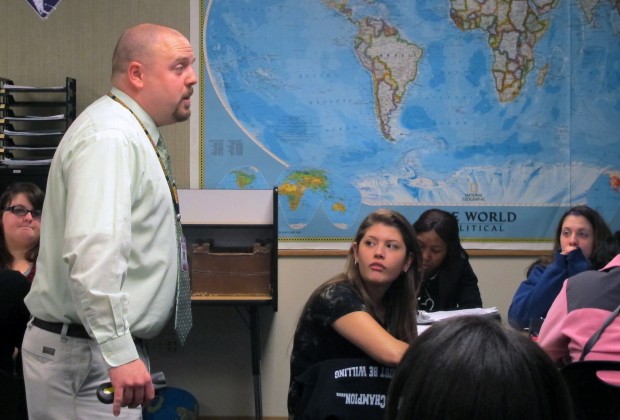A Completed Teacher Evaluation: 'I'm My Own Worst Critic'

Elle Moxley / StateImpact Indiana
Teacher Wes Upton lectures on World War I at Ben Davis Ninth Grade Center in Indianapolis.
Teacher Wes Upton gets high marks on his evaluation, but the ninth grade social studies teacher still sees room for improvement.
“I’m my own worst critic,” he tells Steve Samuel, the assistant principal evaluating him, right before suggesting he be marked down in one category.
Like many districts, Wayne Township is using a modified version of the state’s teacher evaluation model. Teachers are scored in three “domains” — broad categories like planning, instruction and leadership — broken down into multiple subcategories.
We’ll show you what it looks like below. But first, it’s important to understand how the two evaluation systems are different.
Wayne Township uses the state’s RISE rubric, the scorecard the Indiana Department of Education developed. Districts don’t have to use the state’s teacher evaluation system, though many have tweaked RISE to meet their needs. For example, Wayne Township didn’t want to give student test score data as much weight and uses a different formula to calculate final scores.“It’s what’s going on in the classroom,” says David Marcotte, chief personnel officer. “We feel strongly that is what will improve our student’s outcomes.”
So in Wayne Township, 80 percent of a teacher’s score comes from the effectiveness rubric. That means the data component — the part of a teacher’s score that comes from student test scores — is worth 20 percent.
“I thought it was generous for 20 percent to be data,” says Kristen Dawn, a German teacher at Ben Davis High School and president of the Wayne Township Classroom Teachers Association, which provided input to district administrators developing the evaluation system.
“I know some teachers wanted it to be more, and I know some teachers wanted it to not be involved at all, but that just wasn’t realistic given what the state was expecting of public schools.”
But it’s a lot less than in the state’s model, where assessments are worth up to 50 percent of the final evaluation score for teachers whose students take standardized tests.
There’s something else that’s different about Wayne Township’s model: How teachers whose students don’t take standardized tests are scored. The RISE system has teachers set “student learning objectives” and design metrics to measure growth.
But Marcotte says Wayne teachers were already writing common, department assessments. He says it made sense to repurpose those for the evaluation’s data component.
“We had assessments being used for our teachers to make decisions on instructions and to share the data among teachers,” says Marcotte. “We were already producing the data.”
That data will get factored in with scores on the teacher effectiveness rubric in May.
What A Completed Teacher Evaluation Rubric Looks Like
Special thanks to Upton, who let us sit in on his evaluation. Here’s his scorecard with remarks from assistant principal Samuel, courtesy of Wayne Township:
[documentcloud url=https://www.documentcloud.org/documents/606748-teacher-eval-upton.html format=normal sidebar=false ]
